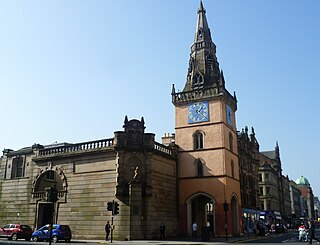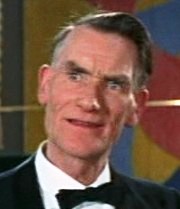
The Theatre Royal is a historic theatre, a Grade I listed building situated on Grey Street in Newcastle upon Tyne.

The Pavilion Theatre is a theatre in Glasgow located on Renfield Street.

The Citizens Theatre, in what was the Royal Princess's Theatre, is the creation of James Bridie and is based in Glasgow, Scotland as a principal producing theatre. The theatre includes a 500-seat Main Auditorium, and two studio theatres, the Circle Studio and the Stalls Studio.

The Theatre Royal is owned by Scottish Opera and is the oldest theatre in Glasgow and the longest running in Scotland. Located at 282 Hope Street, its front door was originally round the corner in Cowcaddens Street. It currently accommodates 1,541 people. The theatre opened in 1867, adopting the name Theatre Royal two years later. It is also the birthplace of Howard & Wyndham Ltd, owners and managers of theatres in Scotland and England until the 1970s, created by its chairman Baillie Michael Simons in 1895. It was Simons who as a cultural entrepreneur of his day also promoted the building of Kelvingrove Art Gallery and Museum and Glasgow's International Exhibitions of 1888 and 1901.

The King's Theatre is located in Glasgow, Scotland. It was built for Howard & Wyndham Ltd under its chairman Baillie Michael Simons as a sister theatre of their Theatre Royal in the city and was designed by Frank Matcham, opening in 1904. The theatre is primarily a receiving house for touring musicals, dance, comedy and circus-type performances. The theatre also provides a prominent stage for local amateur productions. The King's Theatre also stages an annual pantomime, produced by First Family Entertainment

The King's Theatre was opened in 1906 and stands on a prominent site on Leven Street in Edinburgh. It is one of Scotland's historic and important theatres.
Henry Moncrieff Tennent, commonly known as H.M. Tennent or Harry Tennent, was a British theatrical producer, impresario and songwriter. From 1929 to 1933 he mentored Binkie Beaumont, having previously worked with him in Cardiff. When Tennent, already the general manager at the Theatre Royal, Drury Lane, and a senior executive with Moss Empires, persuaded the boards of Moss Empires and of Howard & Wyndham to co-operate, in order the better to produce theatre drama, it was Tennent and Beaumont who became the chief executives of a new shared company HM Tennent Ltd. The largest and controlling shareholders were the Cruikshank family of Howard & Wyndham founded in Glasgow in 1895 and headquartered in Edinburgh.
Howard & Wyndham Ltd was a theatre owning, production and management company of John B. Howard and Frederick W. P. Wyndham, founded in Glasgow in 1895, and which became the largest of its type in Britain. The company continued well into the 20th century; its theatres being eventually sold in the 1960s, and the shareholding coming under American control.

There have been two sites with Theatre Royal in Edinburgh. The first Theatre building on Princes Street opened 1769 and is shown before it was rebuilt in 1830 by Thomas Hosmer Shepherd. The second site was in Broughton Street.

Glasgow Empire Theatre, known as the Glasgow Palace Empire until the early 1900s, was a major theatre in Glasgow, Scotland, which opened in 1897 on the site of the Gaiety Theatre at 31-35 Sauchiehall Street. It was one of the leading theatres in the UK chain of theatres owned and developed by Moss Empires under the chairmanship of Sir Edward Moss, who served his apprenticeship in Greenock and elsewhere.
The Glasgow Unity Theatre was a theatre group that was formed in 1941, in Glasgow. The Unity theatre movement developed from workers' drama groups in the 1930s, seeing itself as using theatre to highlight the issues of the working class being produced by and for working-class audiences. The movement had strong links with the Communist Party of Great Britain and the Left Book Club Theatre Guild.
The Metropole Theatre started as the Scotia and was built in 1862 at 116, Stockwell Street, Glasgow, Scotland. Built to the designs of architect Robert Black for James Baylis, who later built the Theatre Royal in the Cowcaddens area of the city, it opened as the Scotia Hall, holding over 3000 people, with stalls and two galleries, reputed to be the first purpose built commercial music-hall in Scotland. Due to fire in 1875 it was rebuilt to the designs of architects Campbell Douglas and James Sellars and renamed The Scotia Variety Theatre, claiming to be the largest and best variety company in Scotland.
The Theatre Royal in Dumfries, Scotland is the oldest working theatre in Scotland. The Theatre is owned by the Guild of Players who bought it in 1959, thereby saving it from demolition. The Guild's aim is to promote the tradition of live theatre in Dumfries. It is the venue for the Guild of Players' own productions and for performances from visiting companies. In addition it is used extensively as a venue for the Dumfries and Galloway Arts Festival, the Dumfries Music Festival and the Dumfries Musical Theatre Company.

The Scottish Community Drama Association (SCDA) is an association of amateur dramatic clubs throughout Scotland. It was first founded in 1926. Amateur theatre companies in Scotland have generally presented repertoire in English, Lowland Scots and, more occasionally, Scottish Gaelic.
Events from the year 1867 in Scotland.
The 1947 Edinburgh Festival Fringe was the first edition of what would become the world's largest arts festival, the Edinburgh Festival Fringe.
The Palladium Theatre was a theatre in Edinburgh, Scotland.














